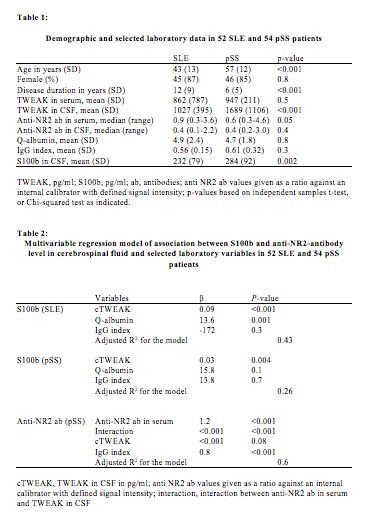Session Information
Date: Tuesday, November 10, 2015
Title: Systemic Lupus Erythematosus - Clinical Aspects and Treatment Poster Session III
Session Type: ACR Poster Session C
Session Time: 9:00AM-11:00AM
Background/Purpose: Neuropsychiatric manifestations are
commonly observed in both SLE and primary Sjšgren’s
syndrome (pSS). However, making an accurate diagnosis can be challenging.
Multiple serum and CSF biomarkers have been studied, but have not yet entered
into routine clinical practice. Studies of the pathogenesis of neuropsychiatric
involvement in SLE and pSS have suggested new biomarker candidates, including
mediators of inflammation (TWEAK), pathogenic antibodies (anti-NMDA receptor
subunit 2 (NR2)), and indicators of increased BBB permeability (S100b).
Methods: In a population-based Caucasian cohort
of 52 SLE and 54 pSS patients (fulfilling ACR and AECG criteria, respectively),
neuropsychiatric manifestations were categorized according to the ACR classification
scheme for lupus neuropsychiatric syndromes. TWEAK and anti-NR2 antibodies (ab)
were measured in the serum and CSF and S100b was measured in the CSF, using
ELISA. IgG index and Q-albumin were calculated by standard methods.
Results: SLE patients were significantly
younger than patients with pSS, yet had longer disease duration. There was no
difference in serum TWEAK between the SLE and pSS groups. While CSF TWEAK (cTWEAK)
and S100b were significantly higher in pSS, patients with SLE displayed
significantly higher serum (but not CSF) anti-NR2 antibody titers (Table 1).
The associations between cS100b and anti-NR2 ab
and selected laboratory variables in the SLE and pSS patient cohorts were
further explored by multivariable regression models (Table 2). The levels of
serum and CSF TWEAK were not related to mood disorders, fatigue, psychosis,
acute confusional state, headache, seizures, or
cerebrovascular disorders. Analysis of possible associations with various cognitive
functions is currently underway.
cS100b demonstrated significant
correlation with cTWEAK in both SLE and pSS. Furthermore, cS100b was associated
with higher BBB permeability in SLE but not in pSS patients. CSF and serum
anti-NR2 antibodies correlated in pSS but not in SLE (Table 2).
Conclusion: Although a normal control group was
not available for comparison, high cTWEAK in pSS points to a possible role of
this cytokine in the pathogenesis of neuropsychiatric manifestations. In pSS, cTWEAK, serum anti-NR2 ab, and
IgG index influence anti-NR2 ab in the CSF, suggesting that both leakage
through the BBB and as well as intrathecal production contribute to CSF
anti-NR2 ab titers. Finally, although this relationship deserves further study,
an interesting and significant association was revealed between S100b and TWEAK
in the CSF in both SLE and pSS.
To cite this abstract in AMA style:
Lauvsnes MB, Tjensvoll AB, Kvivik I, Omdal R, Putterman C. Serum and CSF Biomarkers of Neuropsychiatric Involvement in Primary Sjogren Syndrome and Systemic Lupus Erythematosus [abstract]. Arthritis Rheumatol. 2015; 67 (suppl 10). https://acrabstracts.org/abstract/serum-and-csf-biomarkers-of-neuropsychiatric-involvement-in-primary-sjogren-syndrome-and-systemic-lupus-erythematosus/. Accessed .« Back to 2015 ACR/ARHP Annual Meeting
ACR Meeting Abstracts - https://acrabstracts.org/abstract/serum-and-csf-biomarkers-of-neuropsychiatric-involvement-in-primary-sjogren-syndrome-and-systemic-lupus-erythematosus/

